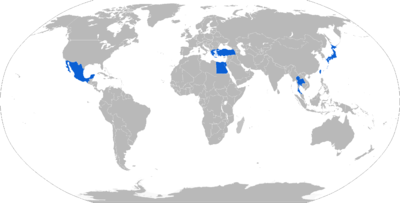5"/54 caliber Mark 42 gun
The Mark 42 5"/54 caliber gun (127mm) is a naval gun (naval artillery) mount used by the United States Navy and other countries. It consisted of the Mark 18 gun and Mark 42 gun mount. United States naval gun terminology indicates the gun fires a projectile 5 inches (127.0 mm) in diameter, and the barrel is 54 calibers long (barrel length is 5" × 54 = 270" or 6.9 meters.)[1] In the 1950s a gun with more range and a faster rate of fire than the 5"/38 caliber gun used in World War II was needed, therefore, the gun was created concurrently with the 3"/70 Mark 26 gun for different usages. The 5"/54 Mk 42 is an automatic, dual-purpose (air / surface target) gun mount. It is usually controlled remotely from the Mk 68 Gun Fire Control System, or locally from the mount at the One Man Control (OMC) station.[2]
| Mark 42 5"/54 Caliber Gun | |
|---|---|
%2C_front.jpg) 5 inch/54 Mark 42 on USS Turner Joy | |
| Type | Naval gun |
| Place of origin | United States |
| Service history | |
| In service | 1953 - present |
| Used by | See users |
| Wars | Vietnam war Lebanese Civil War |
| Specifications | |
| Mass | 60.4 long tons (61.4 t) |
| Length | 9.652 m (31 ft 8.0 in) |
| Barrel length | 6.858 m (270.0 in) Rifling: 5.82 m (229 in) |
| Shell | 127 x 835mm .R Conventional: 31.75 kg (70.0 lb) |
| Caliber | 5 inches (127.0 mm) |
| Recoil | 18.75 inches (476.2 mm) |
| Elevation | • -15°/+85° Maximum elevation rate: 25°/sec |
| Traverse | • 150° from either side of centerline Maximum traversing rate: 40°/sec |
| Rate of fire | As built/designed: 40 rounds per minute automatic Down-rated to 28 rounds per minute in 1968 |
| Muzzle velocity | 2,650 ft/s (807.7 m/s) |
| Maximum firing range | • 25,909 yd (23,691.2 m) at +45° elevation • 51,600 ft (15,727.7 m) at +85° elevation |
The self-loading gun mount weighs about 60.4 long tons (61.4 t) including two drums under the mount holding 40 rounds of semi-fixed case type ammunition. The gun fires 31.75 kg (70.0 lb) projectiles at a velocity of 2,650 ft/s (807.7 m/s).[3] Maximum rate of fire is 40 rounds per minute.[4] Magazine capacity is 599 rounds per mount.[3] The Mark 42 mount originally was equipped for two on-mount gunners, one surface and one antiaircraft, but the antiaircraft gunner position was scrapped later on when the increasing speed of naval aircraft made manual aiming of antiaircraft weapons impractical. The Mark 45 lightweight (22.1 long tons (22.5 t))[5] gun mount began replacing the Mk 42 mount in 1971 for easier maintenance and improved reliability in new naval construction for the United States Navy.[6]
_firing_c1961.jpg)
Users

- First used on USS Northampton
- Forrestal-class aircraft carrier (later removed during upgrade)
- Belknap-class cruiser and USS Truxtun
- Charles F. Adams-class destroyer
- Farragut-class destroyer
- Forrest Sherman-class destroyer
- Mitscher-class destroyer
- Knox-class frigate
- Perth-class destroyer (modified Charles F. Adams class)
- Damiyat-class frigate (ex-USN Knox-class frigates)
- Lütjens-class destroyer (modified Charles F. Adams class)
- Ipiros-class frigate (ex-USN Knox-class frigates)
- Kimon-class destroyer (ex-USN Charles F. Adams-class destroyer)
- Tachikaze-class destroyer
- Hatakaze-class destroyer
- Haruna-class destroyer
- Takatsuki-class destroyer
- Shirane-class destroyer
- Ignacio Allende-class frigate (ex-USN Knox-class frigates)
- Baleares-class frigate (modified Knox class)
- Chih Yang-class frigate (modified ex-USN Knox class)
- Phutthayotfa Chulalok-class frigate (ex-USN Knox-class frigates)

- Turkish Navy
- Muavenet-class frigate (ex-USN Knox-class frigates)
See also
- 5"/38 caliber gun US predecessor
- 5"/54 caliber Mark 45 gun US successor
- QF 4.5 inch Mk I - V naval gun British equivalent
Notes
- Fairfield(1921)p.156
- Seaman - Military manual for the Seaman rate
- Bailey(January 1983)p.106
- O'Neil(March 1971)pp.48-49
- O'Neil, March 1971, pp. 48-49
- Cooney(1980)p.40
Bibliography
- Bailey, Alfred D.; Major USMC (January 1983). "The 16-incher: Big, Big Gun". United States Naval Institute Proceedings. Cite journal requires
|journal=(help) - Cooney, David M.; RADM USN (1980). Ships, Aircraft and Weapons of the United States Navy (NAVSO P-3564). U.S. Government Printing Office.
- Fairfield, A.P. (1921). Naval Ordnance. The Lord Baltimore Press.
- O'Neil, William D. III (March 1971). "Gun Systems? For Air Defense?". United States Naval Institute Proceedings. Cite journal requires
|journal=(help)
External links
| Wikimedia Commons has media related to 5"/54 caliber Mark 42 gun. |